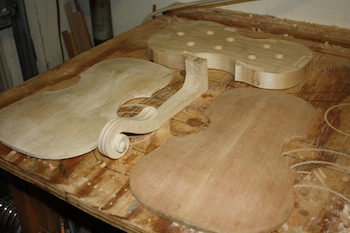
"I have always wanted a violin bass, but I never really seemed to enjoy playing the Hofners. The short scale put me off a bit, but more importantly, I could never relate to how cheap and "plastic" they felt to me. McCartney and others always seemed to get a great sound out of them, but they weren't for me. However, I loved the idea and I wanted a violin bass which was built more like a violin - a high end instrument that I could install some really versatile electronics into and be on my way with a variety of sounds. I realized after a number of years, that if I were ever going to realize the dream of owning a violin bass, I would have to design it and have it built for me." |

CUSTOM DESIGNED, HAND-CRAFTED VIOLA BASS PROTOTYPE
As a starting point, I used this photograph of a Stradivarius violin.
The body was 16" in length and I realized that would be a bit too small for the bass. We extended the dimensions out to 17" which is viola size. For this reason, I always refer to this instrument as a "Viola Bass" and not a "Violin Bass". I also needed to widen the body a bit and create a cutaway so the bass could be playable in the upper register. Pictured above is the pencil sketch that we worked from after tracing and enlarging the body.
A special head stock design for the Viola Bass was drawn up - which I really liked a lot - and decided to go with.
Although I knew the body was a bit cramped and it would create a number of unique design challenges, I decided to transplant the entire electronics package from a Line Six Variax bass into the Viola Bass. The Line Six electronics feature 24 vintage and modern bass sounds "modeled" within the electronics. I spoke to several engineers who assured me that the function of the Line Six electronics was not affected by string length. Even though the original Line Six bass is a full 34" scale, cutting the scale back to medium 32" would have no impact on the way the electronics pick up the signal and do the conversions.
Below is the Line Six bass I purchased off of Ebay to rob the electronics out of. I got a decent price selling the neck to defray costs, but I still have the body. It's hard to tell from this photo, but the body is in perfect shape - with zero scratches or dings. It still has the plastic on the pick guard and the controls. If your Variax body is trashed and you want to start over, this body is for sale and is definitely the one for you.
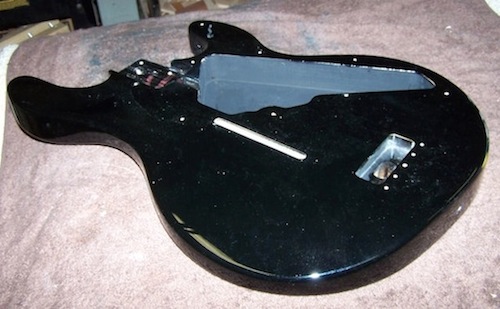
Here are the 24 basses that the Line 6 Variax models. The tone controls follow the original bass tone controls very closely and "lock down" so you can save your favorite tone and it will be recalled instantly with a turn of the dial:
1961 Fender® Jazz Bass®
1960 Fender® Jazz Bass® with flat wound strings
2004 Fender® Deluxe Jazz Bass®
1961 Fender® Fret less Jazz Bass®
1963 Fender® Precision Bass®
1958 Fender® Precision Bass® with flat wound strings
1977 Music Man® Sting Ray®
2003 Modulus® Flea Bass
1971 Rickenbacker® 4001
1963 Rickenbacker® 4001 with flat wound strings
1966 Danelectro® Longhorn Bass
1963 Höfner® Model 500/1 with flat wound strings
1963 Gibson® Thunderbird 4
1966 Gibson® EB-2D with flat wound strings
2002 MTD® 535 35-inch scale
2003 Warwick® Thumb
1978 Alembic Long Scale
1984 Steinberger® XL2
1968 Hagström® H8
1994 Hamer® B12A
2003 Tacoma® Thunderchief
1949 Kay® M-1
Moog MiniMoog bass sounds
Modern bass synth sounds |
We settled on the light, dry mahogany pictured below to use as the core for the instrument, and we traced the Stradivarius pattern and cut out it out from there.
We then chambered the body strategically to make it semi-hollow as below.
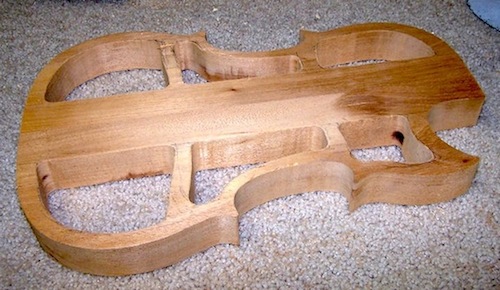 |
We spent a decent amount of time shopping around for the best curly maple we could find within our budget. Curly Maple is also known as Fiddleback Maple, Flame Maple, Tiger Maple, and Tiger stripe Maple. In the US, most use the term Fiddleback Maple and Curly Maple interchangeably. The true difference is that Fiddleback Maple has more wavy lines per inch than the Curly Maple. These waves turn from dark to light and take sharp turns which cause a natural distortion to the eye. It makes the wood look alive when it is moved or viewed at a slightly different angle - because of the differential light reflection or refraction that is caused by the stripes - it causes a natural illusion to the eye. Curly Maple is considered one of the world's most beautiful hardwoods and is sought after by wood aficionados around the world. Here is the maple we chose for the top after book matching and gluing the pieces. You can see the distinct "fiddleback" effect going through the grain.
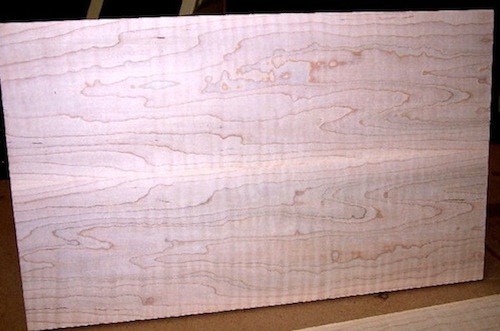 |
And below is what we chose for the back.
Below is what the top looked like after it was cut out:
Below is what the three pieces looked like after cutting out the top and the back and shaping them to fit over the mahogany. The top and back were designed to extend over the mahogany approximately 1/8" to create the lip.
Here is a photo of the initial shaping of the neck, the head stock and the rosewood fingerboard which has been slotted for the frets. The neck was laminated with three pieces of maple for extra strength.
Here is the neck with the fingerboard glued up and the frets installed.
And a nice view of the detail that went into the head stock
Below is a photo of the top being glued up and it also shows how the mahogany chamber had to be slightly altered in order to accept the Line Six Electronics transplant.
Here is another photo showing the rather elaborate process of gluing up the top on.
Here is a photo of the top after carving and roughing in the "F" holes.
And below is a view of the back once it was carved and the main electronics cavity cover completed..
Here are the strips of veneer used for the sides after being soaked in special veneer softener, so that they can be applied and attached to the body edges.
Here is the body, heading for touch up and final sanding after having the veneer applied to the edges - and all of the electronics fitted.
Here is a shot showing the Line Six jack plate.
And the playable version of the bass.....
FINISH BY KEITH ROSCOE
I had several options for applying the finish to the bass, but no one was as enthusiastic as my friend Keith Roscoe of Roscoe Guitars. I have known Keith for nearly 15 years and he has made two incredible custom basses for me. I sent the bass to Keith and let him have his way with it. His finishing work is second to none and he called me after living with the bass a week or so and gave me some gobbledygook about nitrocellulose vs. varnish vs. polyurethane and I just said - "Keith, I don't care what you use or if you combine and make it a hybrid finish - do your thing, use your judgment and imagination - make it killer and make it look like a violin." Once again, if you want to know what the final verdict is on the finish, you would have to ask Keith. He did an incredible job and the finish work is amazing.
Before sending the body to Keith I had one of the best set-up pros in the business - John Ingram of Annapolis, and formerly of PRS Guitars - disassemble it for me. I knew John was going to do the set up work and I wanted him to disassemble the delicate electronics so that he knew where everything went when it came back for re-assembly. Here are some photos of the Roscoe team doing their thing on the finish. First, the base coat of vintage amber.
Then the tinting and edging process with the rich brown.
I really wanted the cavity covers black, although it broke my heart to finish over that beautiful maple.
After finishing, it was back to Annapolis to John, so that he could assemble the bass and set it up so that it plays like a dream.
THE TECHNICAL STUFF
This is the custom, hand-crafted, medium scale prototype Viola Bass I designed, which features a light, dry chambered mahogany core with book matched curly "fiddleback" maple top and back. As above, this bass was built more like a violin or viola than a conventional bass or guitar. This bass weighs in at 7.8 lbs and the width of the neck at the nut is 43.5mm. The neck is three piece laminated curly red maple for strength. It is bolted on with a six bolt design. The fingerboard is a beautiful piece of rosewood and the tuners are Hipshot Ultra Light. The bridge and piezos are standard Line Six Variax. The entire electronics package is a transplant from a Line Six Variax Bass, which features 24 separate "modeled" vintage and modern bass sounds. All of the sounds have tone controls which are very close to the original instruments, so you can dial in the tone you like for each instrument and "save" it to the rotary control knob. As you turn the knob to dial through your basses, your exact tone settings come up with the selection of the instrument. The bass is powered by the Variax Line Six power supply or by batteries contained in the body cavity. The custom finish is by Keith Roscoe and his staff at Roscoe Guitars, in Greensboro, North Carolina. All features of the Line Six electronics work immaculately and thanks to the final set-up work by John Ingram, formerly of PRS guitars - this bass plays like a dream. I have 24 great reasons not to put it down.
CUSTOM VIOLA BASS PROTOTYPE SPECS
Model: Viola Bass
Color: Amber Violin Custom Finish by Keith Roscoe
Core Body Material: Mahogany
Top and Back: Fiddleback Curly Maple
Sides: Fiddleback Curly Maple Veneer
Body Finish: Satin Polyurethane
Body Shape: Modified Strativarius Violin Shape
Neck Material: Three Piece Fiddleback Curly Maple
Neck Finish: Satin Polyurethane
Neck Shape: Fender Japan Medium Scale P Bass Copy
Fingerboard: Rosewood
Scale Length: 32"
Number of Frets: 21
Nut Width: 43.5mm
Position Inlays: None
Pickups: Line Six Variax Piezos in Bridge Saddles
Electronic Controls: Standard Line Six Varax Controls
Bridge: Original chrome Variax
Hardware Finish: Chrome HipShot Ultra Light Tuners
Pickguard: None
Strings: D'Addario Half Rounds ENR70 (.040-.095 Gauges)
Unique Feature: Custom Open Headstock
BASS SOUNDS AVAILABLE ON THE VIOLA PROTOTYPE
1961 Fender® Jazz Bass®
1960 Fender® Jazz Bass® with flat wound strings
2004 Fender® Deluxe Jazz Bass®
1961 Fender® Fret less Jazz Bass®
1963 Fender® Precision Bass®
1958 Fender® Precision Bass® with flat wound strings
1977 Music Man® Sting Ray®
2003 Modulus® Flea Bass
1971 Rickenbacker® 4001
1963 Rickenbacker® 4001 with flat wound strings
1966 Danelectro® Longhorn Bass
1963 Höfner® Model 500/1 with flat wound strings
1963 Gibson® Thunderbird 4
1966 Gibson® EB-2D with flat wound strings
2002 MTD® 535 35-inch scale
2003 Warwick® Thumb
1978 Alembic Long Scale
1984 Steinberger® XL2
1968 Hagström® H8
1994 Hamer® B12A
2003 Tacoma® Thunderchief
1949 Kay® M-1
Moog MiniMoog bass sounds
Modern bass synth sounds
   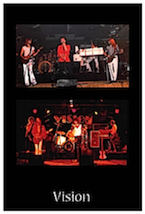
Please click on any of the photos directly above to proceed to those pages. | 
